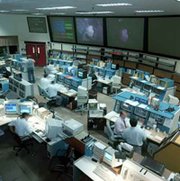Deep Space Network
|
|
Deep Space Network (DSN) is an international network of radio antennas that supports interplanetary spacecraft missions, and radio and radar astronomy observations for the exploration of the solar system and the universe. The network also supports selected Earth-orbiting missions. DSN is part of the NASA Jet Propulsion Laboratory (JPL).
| Contents |
General information
DSN currently consists of three deep-space communications facilities placed approximately 120 degrees apart around the world at:
- the Goldstone Deep Space Communications Complex outside of Barstow, California, United States;
- a complex in Robledo de Chavela, 60 kilometres (37 miles) west of Madrid, Spain; and
- the Canberra Deep Space Communications Complex (CDSCC) in the Australian Capital Territory, 40 kilometres (25 miles) southwest of Canberra, Australia near the Tidbinbilla Nature Reserve.
Each facility is situated in semi-mountainous, bowl-shaped terrain to shield against radio frequency interference. This strategic placement permits constant observation of spacecraft as the Earth rotates, and helps to make the DSN the largest and most sensitive scientific telecommunications system in the world.
NASA's scientific investigation of the Solar System is being accomplished mainly through the use of unmanned spacecraft. The DSN provides the vital two-way communications link that guides and controls these planetary explorers, and brings back the images and new scientific information they collect. All DSN antennas are steerable, high-gain, parabolic reflector antennas.
The antennas and data delivery systems make it possible to:
- Acquire telemetry data from spacecraft.
- Transmit commands to spacecraft.
- Track spacecraft position and velocity.
- Perform very-long-baseline interferometry observations.
- Measure variations in radio waves for radio science experiments.
- Gather science data.
- Monitor and control the performance of the network.
The network is a facility of the JPL and is managed and operated for NASA by the California Institute of Technology (Caltech). The Interplanetary Network Directorate (IND) manages the program within JPL.
Antennae
Goldstone_DSN_antenna.jpg
Each complex consists of at least four deep space stations equipped with ultrasensitive receiving systems and large parabolic dish antennas. There are:
- One 34-metre (111-foot) diameter High Efficiency antenna.
- One 34-metre Beam Waveguide antenna (Three at the Goldstone Complex and two at the Madrid complex).
- One 26-metre (85-foot) antenna.
- One 70-metre (230-foot) antenna.
Five new 34-metre beam waveguide antennas were added to the system in the late 1990s. Three were located at Goldstone, and one each in both Canberra and Madrid. A second 34-metre beam waveguide antenna was completed at the Madrid complex in 2004.
The ability to array several antennas was installed to improve the data returned from the Galileo spacecraft. The array electronically links the 70-metre antenna at the Deep Space Network complex in Goldstone, California, with an identical antenna located in Australia, in addition to two 34-metre (111-foot) antennas at the Canberra complex. The California and Australia sites concurrently pick up communications with Galileo.
All the stations are remotely operated from a centralized Signal Processing Center at each complex. The Centers house the electronic subsystems that point and control the antennas, receive and process the telemetry data, transmit commands, and generate the spacecraft navigation data.
Once the data are processed at the complexes, it is transmitted to JPL for further processing and distribution to science teams over a modern ground communications network.
History
The forerunner of the DSN was established in January, 1958, when JPL, then under contract to the U.S. Army, deployed portable radio tracking stations in Nigeria, Singapore, and California to receive telemetry and plot the orbit of the Army-launched Explorer 1, the first successful U.S. satellite. NASA was officially established on October 1, 1958, to consolidate the separately developing space-exploration programs of the Army, Navy, and Air Force into one civilian organization.
On December 3, 1958, JPL was transferred from the Army to NASA and given responsibility for the design and execution of lunar and planetary exploration programs using automatically operated spacecraft. Shortly afterward, NASA established the concept of the Deep Space Network as a separately managed and operated communications facility that would accommodate all deep space missions, thereby avoiding the need for each flight project to acquire and operate its own specialized space communications network. The Deep Space Network was given responsibility for its own research, development, and operation in support of all of its users. Under this concept, it has become a world leader in the development of low-noise receivers, tracking, telemetry and command systems, digital signal processing, and deep space navigation.
Related topics
External links and Further Reading
- NASA/Caltech JPL DSN (http://deepspace.jpl.nasa.gov/dsn/) - official site.
- (PDF) Uplink-Downlink: A History of the Deep Space Network, 1957-1997 (NASA SP-2001-4227) (http://history.nasa.gov/SP-4227/Uplink-Downlink.pdf).
- Douglas J. Mudgway, Big Dish: Building America's Deep Space Connection to the Planets, University of Florida Press, 2005 ISBN 0813028051.de:Deep Space Network

